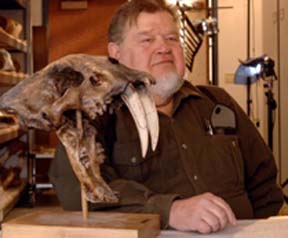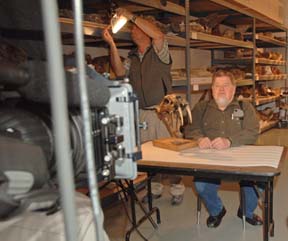National Geographic TV taps ISU sabertoothed-cat expert
November 2, 2006
On Halloween a television production crew came trick-or-treating at the Idaho Museum of Natural History on the Idaho State University campus. This group didn’t come looking for candy, but rather for television footage. Their subject was Dr. Bill Akersten, the IMNH’s curator of vertebrate paleontology who is an expert on the prehistoric sabertoothed cat.
 Rich Ross, producer for Creative Differences, a television production firm based in the Los Angeles area, headed a production team that journeyed to the museum to interview Akersten about the sabertoothed cat for the National Geographic channel. The interview will be part of a three-episode series about late-Pleistocene carnivores. One episode will focus on the sabertoothed cat, while the others will showcase the short-faced bear and the Dire wolf.
Rich Ross, producer for Creative Differences, a television production firm based in the Los Angeles area, headed a production team that journeyed to the museum to interview Akersten about the sabertoothed cat for the National Geographic channel. The interview will be part of a three-episode series about late-Pleistocene carnivores. One episode will focus on the sabertoothed cat, while the others will showcase the short-faced bear and the Dire wolf.
“We’re really trying to bring the Pleistocene period to life,” said Ross in regard to the new series scheduled to run sometime in the spring of 2007. While the series starts its examination of these Pleistocene mammals at the Rancho La Brea Tar Pits in Los Angeles, Ross says their focus certainly isn’t limited to that area.
“What we’re really trying to get into was what the sabertoothed cat’s canine teeth were for and how they used them and, more importantly, why these creatures became extinct,” Ross said.
Akersten was selected for the series because of his 15 years of experience at Rancho La Brea prior to coming to the IMNH. From 1972 to 1985, he worked for the Natural History Museum of Los Angeles County as coordinator of the Rancho La Brea Project, curator of Rancho La Brea, and curator of Pleistocene vertebrates. While there, Akersten worked closely on the sabertoothed cat fossil remains that were found in the tar pits, as well as the remains of other Pleistocene mammals collected there.
Akersten got hooked up with the television production company through his contacts at La Brea. “Everybody who does anything with sabertoothed cats has to go through La Brea,” Akersten said. “One of my former assistants there talked with the production crew and suggested they contact me, so they did.”
“They are a strange creature,” Akersten said of the sabertoothed cat. “When you work with hundreds of them, you get interested.” Akersten’s interest led him to publish a paper in 1985 showing that the sabertoothed cats could not stab with their canine teeth, but rather bit with them. “The structure of the muscles and bones of the jaw and cranium, along with the other teeth showed that stabbing was impossible,” Akersten explained.
The interview corresponds nicely with a project Akersten is working on for the ISU Biology department. In May 2008, ISU will host a symposium on sabertoothed mammals and Akersten is heading up that effort. The symposium, which Akersten believes will have 40 to 50 attendees, will focus on various types of sabertoothed mammals including the sabertoothed cat.
Categories:
